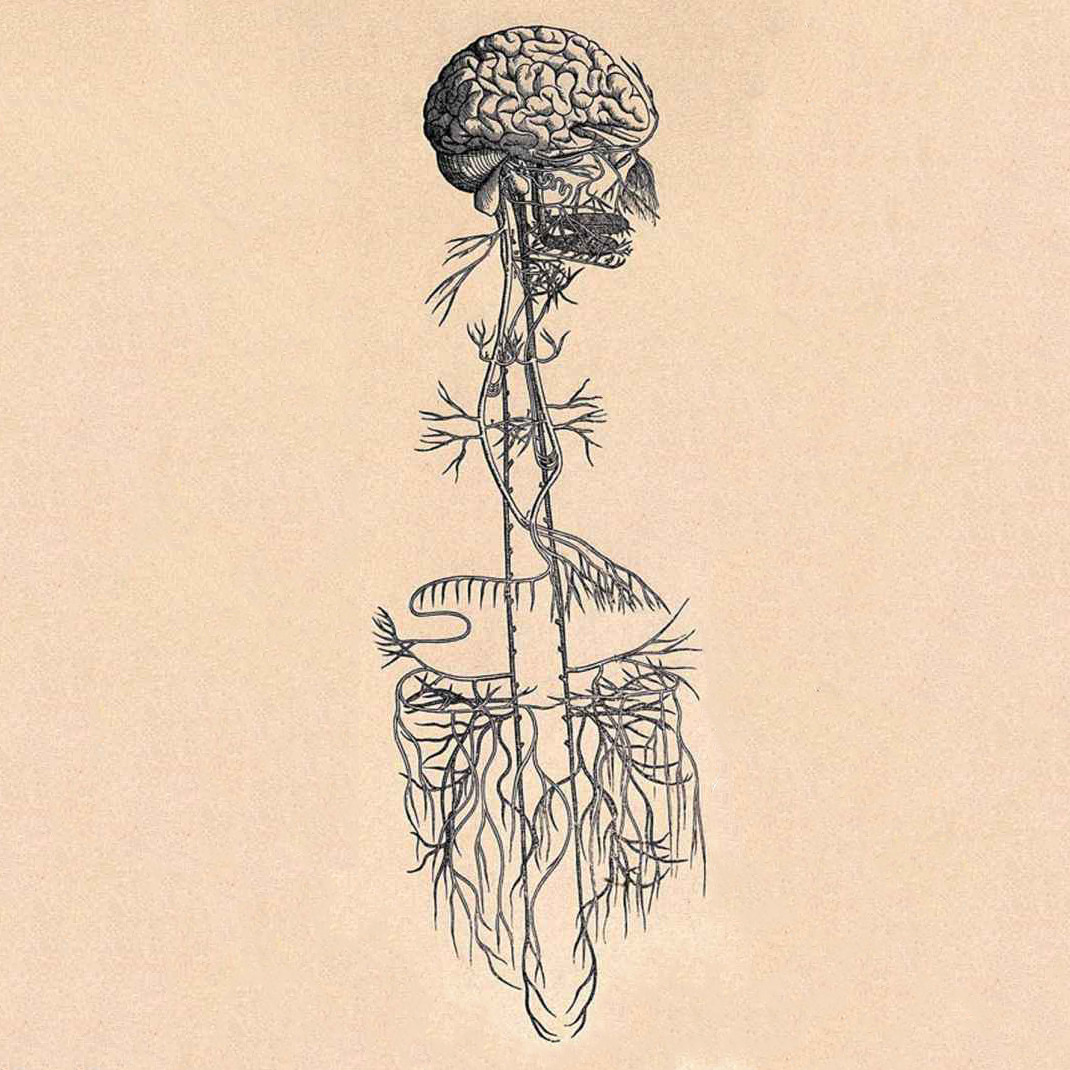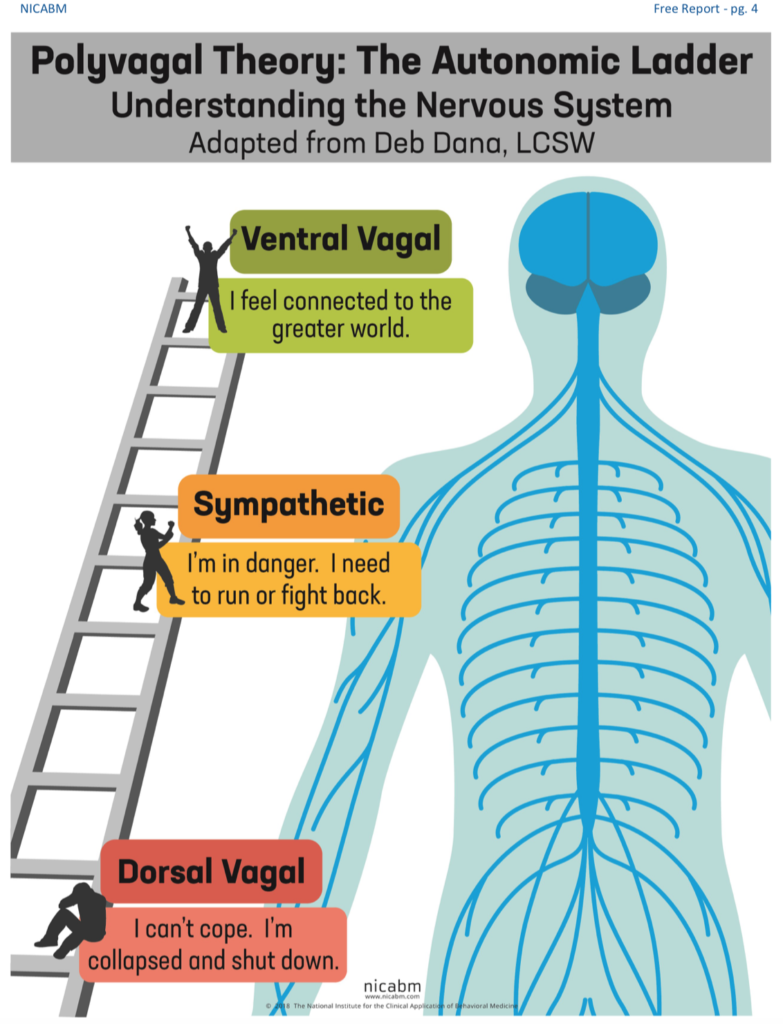I’ve been learning lately about polyvagal theory, developed by Stephen Porges. I find it to be a really clear and helpful way of thinking about our feeling states that can give us more agency to feel better.
The theory is based on Porges’ research of  the vagus nerve, a nerve with several branches that wanders from the brain to the internal organs below the diaphragm and also up into the face. Consequently the name vagus comes from the latin for vagrant or wanderer.
the vagus nerve, a nerve with several branches that wanders from the brain to the internal organs below the diaphragm and also up into the face. Consequently the name vagus comes from the latin for vagrant or wanderer.
Story follows state
Polyvagal theory shows that from the moment of birth our autonomic nervous system, without us thinking about it, is constantly scanning for signs of safety or danger. This scanning process is called neuroception.
What I find particularly interesting is that Porges has shown that neuroception happens before perception. This means that it happens automatically prior to any conscious awareness.
The Autonomic Ladder
A neuroception of safety brings us into a ventral vagal state, at the top of the “ladder”. This is a state of social engagement and connection. From this state you might say the world is a safe place and describe yourself as happy, active and interested. As Porges says, story follows state.
If something happens to alert us to danger (e.g. you are driving and you hear police car sirens, your boss asks for a meeting in a stern tone), we go into a sympathic nervous system state of mobilisation. This is the state of fight or flight and is evolutionarily linked to mammals. We feel adrenalin, feel anxious or angry and ready for action. The world may feel dangerous, chaotic, unfriendly. You may feel you need to protect yourself.
Going down a step on the ladder, if we sense signs of extreme danger, neurologically we go into the dorsal vagal state of immobilisation. Think of a turtle drawing its head inside its shell. You might feel frozen, numb, not here, alone, hopeless. From here the world is not safe.
Shifting states
Throughout the day we shift through these states. We work our way up and down the ladder. Some of us live mostly in the ventral vagal zone, but others, often due to adverse life circumstances and trauma, tend to spend more time further down the ladder and have a harder time “climbing” up.
The more time we spend on different points on the ladder, the more we’re likely to get stuck in negative patterns. Porges even suggests we develop related physical symptoms.
Polyvagal-informed therapy offers tools to help you be closer to the top of the ladder, more of the time. In Deb Dana’s excellent book, The Polyvagal Theory in Therapy which informs this article, there many tools for mapping out your own nervous system ladder, including how you can help yourself climb up the ladder.
How can this theory help you?
Understanding your nervous system in this way can change the way you think of these states in yourself. Therefore there can be less self-judgement and more compassion for your state.
By recognising what state you are in a given moment, and understanding how you shift between states, you can change your state so you can feel connected and safer more of the time. You can feel less hopeless when you’re in the dorsal vagal shut down state, as you’ll know ways to help yourself out of it. You can also more easily enlist the help of others in this, since as mammals we need connection with others to feel safe.
This theory, as I mentioned above, is especially relevant for those with trauma in their background. A trauma history often creates a hyper- or hypo-vigilant state, where either one is scanning for safety all of the time, and one can interpret neutral events or interactions as threatening ones, or one is shut down and depressed. This is a natural result of trauma as our nervous systems have had to protect us against danger, and have now got used to that protection mode. The good news is that through positive connections (and possibly some therapy) we can help retrain the nervous system to be able to relax and feel safe.
For more information read Deb Dana’s article A Beginner’s Guide to Polyvagal Theory. Dana also has worksheets available but do check her guidelines first from her other writing to make it safe and to get the full benefit of the exercises. I would also be happy to help you complete your own maps.
Much of the embodied work I specialise in helps regulate nervous system states to bring you “up the ladder”. See the following articles for examples of this.
Related articles
- Embodied Therapy: what it is and why it matters
- Mindfulness tools for everyday sanity
- Anxiety Soup: a personal story
- How to healthily relate to anger
- I remember the place (video of qi gong exercise)
- The power of play
- The Eel and the Axe Man: a therapy session
If you’re interested in working with me, get in touch! I’m also running a new group called Inner Work Studio where you can learn and practice key experiential tools. It is 8-weeks long and begins October 2021.




